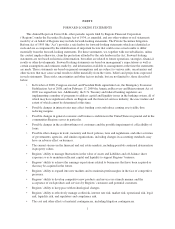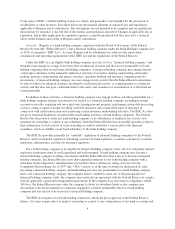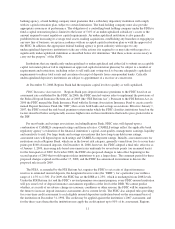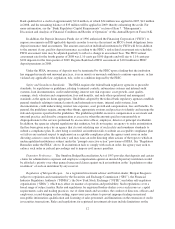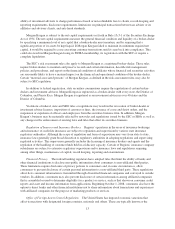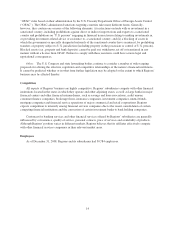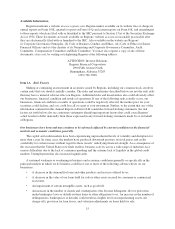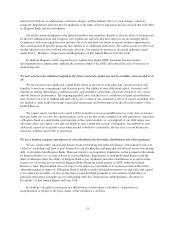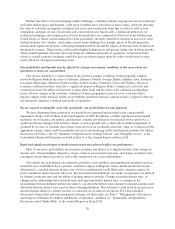Regions Bank 2008 Annual Report Download - page 21
Download and view the complete annual report
Please find page 21 of the 2008 Regions Bank annual report below. You can navigate through the pages in the report by either clicking on the pages listed below, or by using the keyword search tool below to find specific information within the annual report.banking agency, a bank holding company must guarantee that a subsidiary depository institution will comply
with its capital restoration plan, subject to certain limitations. The bank holding company must also provide
appropriate assurances of performance. The obligation of a controlling bank holding company under the FDIA to
fund a capital restoration plan is limited to the lesser of 5.0% of an undercapitalized subsidiary’s assets or the
amount required to meet regulatory capital requirements. An undercapitalized institution is also generally
prohibited from increasing its average total assets, making acquisitions, establishing any branches or engaging in
any new line of business, except in accordance with an accepted capital restoration plan or with the approval of
the FDIC. In addition, the appropriate federal banking agency is given authority with respect to any
undercapitalized depository institution to take any of the actions it is required to or may take with respect to a
significantly undercapitalized institution as described below if it determines “that those actions are necessary to
carry out the purpose” of the FDIA.
Institutions that are significantly undercapitalized or undercapitalized and either fail to submit an acceptable
capital restoration plan or fail to implement an approved capital restoration plan may be subject to a number of
requirements and restrictions, including orders to sell sufficient voting stock to become adequately capitalized,
requirements to reduce total assets and cessation of receipt of deposits from correspondent banks. Critically
undercapitalized depository institutions are subject to appointment of a receiver or conservator.
At December 31, 2008, Regions Bank had the requisite capital levels to qualify as well capitalized.
FDIC Insurance Assessments. Regions Bank pays deposit insurance premiums to the FDIC based on an
assessment rate established by the FDIC. In 2006, the FDIC enacted various rules to implement the provisions of
the Federal Deposit Insurance Reform Act of 2005 (the “FDI Reform Act”). Pursuant to the FDI Reform Act, in
2006 the FDIC merged the Bank Insurance Fund with the Savings Association Insurance Fund to create a newly
named Deposit Insurance Fund (the “DIF”) that covers both banks and savings associations. Effective January 1,
2007, the FDIC revised the risk-based premium system under which the FDIC classifies institutions based on the
factors described below and generally assesses higher rates on those institutions that tend to pose greater risks to
the DIF.
For most banks and savings associations, including Regions Bank, FDIC rates will depend upon a
combination of CAMELS component ratings and financial ratios. CAMELS ratings reflect the applicable bank
regulatory agency’s evaluation of the financial institution’s capital, asset quality, management, earnings, liquidity
and sensitivity to risk. For large banks and savings associations that have long-term debt issuer ratings,
assessment rates will depend upon such ratings and CAMELS component ratings. Initially, assessment rates for
institutions such as Regions Bank, which are in the lowest risk category, generally varied from five to seven basis
points per $100 of insured deposits. On December 16, 2008, however, the FDIC adopted a final rule, effective as
of January 1, 2009, increasing risk-based assessment rates uniformly by seven basis points (on an annual basis)
for the first quarter of 2009. In October 2008, the FDIC also proposed changes to take effect beginning in the
second quarter of 2009 that would require riskier institutions to pay a larger share. The comment period for these
proposed changes expired on December 17, 2008, and the FDIC has announced its intention to discuss the
proposed rule in early 2009.
The FDIA, as amended by the FDI Reform Act, requires the FDIC to set a ratio of deposit insurance
reserves to estimated insured deposits, the designated reserve ratio (the “DRR”), for a particular year within a
range of 1.15% to 1.50%. For 2009, the FDIC has set the DRR at 1.25%, which is unchanged from 2008 levels.
Under the FDI Reform Act and the FDIC’s revised premium assessment program, every FDIC-insured institution
will pay some level of deposit insurance assessments regardless of the level of the DRR. We cannot predict
whether, as a result of an adverse change in economic conditions or other reasons, the FDIC will be required in
the future to increase deposit insurance assessments above current levels. The FDIC also adopted rules providing
for a one-time credit assessment to each eligible insured depository institution based on the assessment base of
the institution on December 31, 1996. The credit may be applied against the institution’s 2007 assessment, and
for the three years thereafter the institution may apply the credit against up to 90% of its assessment. Regions
11


